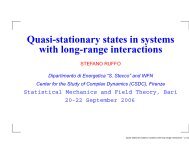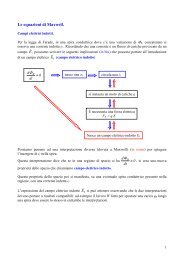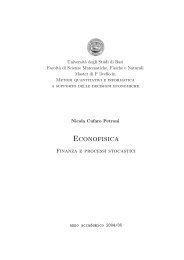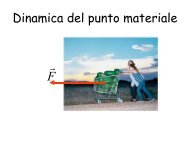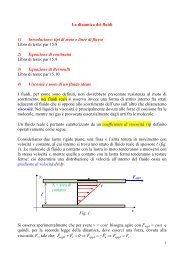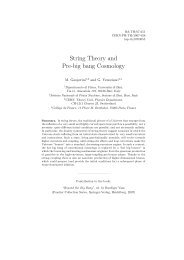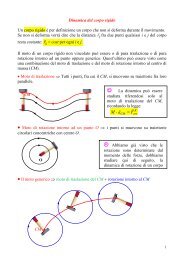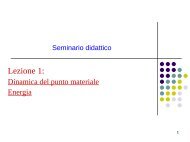Pricing and Hedging Asian Basket Options with Quasi-Monte ... - Infn
Pricing and Hedging Asian Basket Options with Quasi-Monte ... - Infn
Pricing and Hedging Asian Basket Options with Quasi-Monte ... - Infn
You also want an ePaper? Increase the reach of your titles
YUMPU automatically turns print PDFs into web optimized ePapers that Google loves.
Methodol Comput Appl Probab1 Introduction <strong>and</strong> MotivationIn a few recent papers Dahl <strong>and</strong> Benth (2002) <strong>and</strong> Wang (2009) have investigatedthe efficiency <strong>and</strong> the computational cost of the Principal Component Analysis(PCA) used in the <strong>Quasi</strong>-<strong>Monte</strong> Carlo (QMC) simulations for the pricing of highdimensional<strong>Asian</strong> basket options in a multi-dimensional Black–Scholes (BS) model<strong>with</strong> constant volatilities. In particular they have shown the essential role of theKronecker product both for a fast implementation, <strong>and</strong> for identifying the effectivedimension in the analysis of variance (ANOVA, see below). Since the convergencerate of the QMC method is O ( N −1 log d N ) —here N is the number of simulationtrials, <strong>and</strong> d the nominal dimension of the problem—the theoretically higher asymptoticconvergence rate of QMC could not be practically achieved in high dimensions.On the other h<strong>and</strong>, particular applications in finance (see Paskov <strong>and</strong> Traub 1995)have shown that the QMC provides an accuracy higher than the st<strong>and</strong>ard <strong>Monte</strong>Carlo (MC) even for high dimensions.To explain the success of the QMC in high dimensions Caflisch et al. (1997)have introduced two notions of effective dimensions based on the ANOVA ofthe integr<strong>and</strong> function. Consider an integr<strong>and</strong> function f for a MC problem <strong>with</strong>nominal dimension d,<strong>and</strong>letA ={1,...,d} denote the labels of the input variablesof the function f : the effective dimension of f in the superposition sense is thesmallest integer d S such that ∑ |u|≤d Sσ 2 ( f u ) ≥ pσ 2 ( f ), where f u is a function <strong>with</strong>variables in the set u ⊆ A , σ 2 (·) denotes the variance of the given function, |u| is thecardinality of the set <strong>and</strong> 0 ≤ p ≤ 1 (for instance p = 0.99). On the other h<strong>and</strong> theeffective dimension of f in the truncation sense is the smallest integer d T such that∑u⊆{1,2,...,d T } σ 2 ( f u ) = pσ 2 ( f ). In other words the truncation dimension indicates thenumber of variables essential to capture the given function f , while the superpositiondimension takes into account that, for some f ’s, the inputs might influence theoutcome through their joint action <strong>with</strong>in smaller groups.Different techniques have been proposed for a dimension reduction: the PCAdecomposition <strong>and</strong> the Brownian bridge (BB) however achieve this result independentlyfrom the particular payoff of a European option. Imai <strong>and</strong> Tan (2006) haveinstead proposed a general dimension reduction construction, the Linear Transformation(LT), that depends on the payoff function, <strong>and</strong> that minimizes the effectivedimension in the truncation sense. Several studies have investigated the efficiency ofthe dimension reduction produced by these approaches. Wang (2009), for example,has shown that the accuracy of the QMC simulations depends on both the dimensionreduction technique, <strong>and</strong> the quasi-r<strong>and</strong>om points. He also proved that the PCAdecomposition is always outperforming the BB as a result of the different groupingstrategies developed (see the cited article for more details). Moreover, Papageorgiou(2002) has demonstrated that the accuracy of the QMC method used for thepricing of certain specific derivative contracts is not substantially improved by aBB construction. Finally Imai <strong>and</strong> Tan (2006) have shown that the LT approachis more accurate than the st<strong>and</strong>ard PCA <strong>and</strong> BB, but has a higher computationalcost. In a previous paper one of the authors (Sabino 2011) has described how toefficiently implement this technique <strong>and</strong>, even <strong>with</strong> a slower computer, has obtainedcomputational times that are about 30 times shorter than those originally presentedby Imai <strong>and</strong> Tan (2006).In the present paper we address the problem of the time-dependent volatilities,<strong>and</strong> since we can no longer rely on the properties of the Kronecker product, our task



